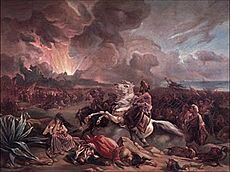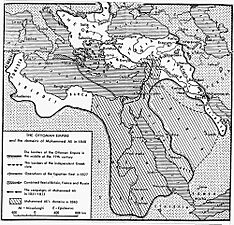Egyptian–Ottoman War (1831–1833) facts for kids
Quick facts for kids First Egyptian–Ottoman War |
|||||||||
|---|---|---|---|---|---|---|---|---|---|
| Part of the campaigns of Muhammad Ali of Egypt | |||||||||
 Map of Syria, 1851. |
|||||||||
|
|||||||||
| Belligerents | |||||||||
supported by: |
|||||||||
| Commanders and leaders | |||||||||
| Strength | |||||||||
| 1832: 100,000 |
1832: 145,000 |
||||||||
The First Egyptian–Ottoman War (1831–1833) was a big fight between the Ottoman Empire and Egypt. It's also called the First Syrian War. The war started because Muhammad Ali Pasha, the ruler of Egypt, wanted control of Greater Syria. He felt he deserved it for helping the Ottoman Sultan during the Greek War of Independence. Because of this war, Egyptian forces took control of Syria for a while. They even pushed far north into what is now Turkey, reaching a city called Kütahya.
Why the War Started
Muhammad Ali Pasha had big plans for Egypt. He wanted to expand his rule into the Ottoman Empire's Syrian lands. He even told the British consul about his ideas as early as 1812. But first, he focused on making Egypt stronger. He improved the government, public services, and the army. He also put down several rebellions, like those by the Mamluks and the Wahhabis. He did all this on behalf of the Ottoman Sultan, Mahmud II.
In 1825, Sultan Mahmud II asked Muhammad Ali for help again. This time, it was to stop a rebellion by Greek Christians who wanted their independence. The Sultan promised Muhammad Ali control over Crete, Cyprus, and the Morea (modern Peloponnese) if he helped. Muhammad Ali's son, Ibrahim Pasha, led the Egyptian army. He quickly won battles and controlled most of the Peloponnese within 10 months.
However, the Greeks kept fighting using guerrilla tactics. By 1827, powerful European countries like Russia, Britain, and France decided to help the Greeks. Their combined navies destroyed Muhammad Ali's fleet at the Battle of Navarino. A year later, Ibrahim's forces had to leave Greece. Once Ibrahim and his army returned to Egypt, they started getting ready to take control of Syria.
Egypt Invades Syria
The governor of Acre, Abdullah Pasha ibn Ali, was hiding people who had run away from the Egyptian army. He also refused to help Muhammad Ali's war efforts. Using these reasons, Muhammad Ali sent his land and sea forces north. These forces were led by Ibrahim Pasha. In October 1831, they began to besiege Acre.
The city of Acre finally fell to Ibrahim's army six months later, in May 1832. After taking Acre, Ibrahim continued his victories. He gained control of important cities like Aleppo, Homs, Beirut, Sidon, Tripoli, and Damascus. The armies sent by the Sultan and local governors could not stop Ibrahim's forces. A key battle was the Battle of Homs, which decided the fate of Syria.
The Ottoman Sultan, Mahmud II, was trying to modernize his army with new methods like conscription (drafting soldiers) and mass training. But he faced many problems. Muhammad Ali, however, had successfully adopted these modern military ideas. Ibrahim's success wasn't just because of modern organization. His officers had much more experience than the Ottoman officers. They had fought in the Empire's two most recent major wars against the Wahhabis and the Greeks. Ibrahim also gained support from local people. He told them his campaign was about "liberation from the Turkish yoke." With Greater Syria under his control, the Egyptian army continued its campaign into Anatolia (modern Turkey) in late 1832.
The Battle of Konya
On November 21, 1832, the Egyptian forces took the city of Konya. This city is in central Turkey, close enough to threaten the Ottoman capital, Constantinople. The Sultan quickly put together a new army of 80,000 men. This army was led by Reshid Mehmed Pasha, the Grand Vizier (a top minister). This was the Sultan's last try to stop Ibrahim's march towards the capital.
Ibrahim had about 50,000 men, but most were spread out along his supply routes from Cairo. He only had 15,000 soldiers with him in Konya. Even so, when the armies met on December 21, Ibrahim's forces won easily. They even captured the Grand Vizier, who got lost in the fog while trying to rally his troops. The Egyptians had only 792 casualties (dead or wounded). The Ottoman army, however, lost 3,000 men and 46 of their 100 cannons. This amazing victory at Konya was the final and most impressive win for the Egyptian campaign. It marked the highest point of Muhammad Ali's power in the region.
What Happened Next
After the Battle of Konya, there were no more Ottoman armies between the Egyptians and Constantinople. This was a huge defeat for the Ottomans. Egypt had conquered almost all of Turkey, except for Constantinople itself. Harsh winter weather forced Ibrahim to stop at Konya. This gave the Ottoman Sultan time to make an alliance with Russia. Russian forces then arrived in Anatolia, blocking Ibrahim's path to the capital. The arrival of Russia's power was too much for Ibrahim's army to overcome.
European countries, especially France and Britain, were worried about Russia gaining too much influence over the Ottoman Empire. They didn't want the balance of power in Europe to be upset. So, they pressured Muhammad Ali and Ibrahim to agree to a peace deal called the Convention of Kütahya. Under this agreement, the Syrian provinces were given to Egypt. Ibrahim Pasha was made the governor-general of the region.
The treaty meant that Muhammad Ali was still officially a ruler under the Sultan, but he had a lot of independence. Six years later, Muhammad Ali tried to declare full independence for Egypt. The Sultan then called him a traitor and sent an army to fight Ibrahim Pasha. This started the Second Egyptian–Ottoman War.
See also
- Military of ancient Egypt
- Egyptian Armed Forces
- Egyptian Army
- List of wars involving Egypt
- Treaty of Hünkâr İskelesi



